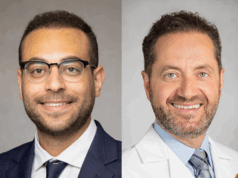
An analysis of the worldwide experience of transcarotid artery revascularisation (TCAR) has produced key objective proficiency metrics and an analytic framework to assess adequate training for the procedure. “Training on cadavers or synthetic models achieved clinical outcomes, technical outcomes and proficiency measures for subsequently performed TCAR procedures similar to those achieved with training using traditional proctoring on live cases,” Brajesh K Lal (University of Maryland, Baltimore, USA) and colleagues conclude in the Journal of Vascular Surgery (JVS).
“TCAR is a new hybrid approach to carotid artery revascularisation,” the authors begin. They note, however, that proctored training on live cases is an “effort-, time-, and resource-intensive approach to learning new procedures.” Against this backdrop, Lal et al analysed the worldwide experience with TCAR to develop objective performance metrics for the procedure and compared the effectiveness of training physicians using cadavers or synthetic models to traditional in-person training on live cases.
The researchers describe how physicians underwent one of three mandatory training programmes: (1) in-person proctoring on live TCAR procedures; (2) supervised training on human cadavers; and (3) supervised training on synthetic models. Lal and colleagues then compared the adverse event rates between the procedures performed by physicians after undergoing the three training modes and tested whether the proficiency measures achieved during TCAR after training on cadavers and synthetic models were non-inferior to proctored training.
Lal et al communicate that, in the period 3 March 2009 to 7 May 2020, 1,160 physicians underwent proctored (19.1%), cadaver-based (27.4%) and synthetic model-based (53.5%) TCAR training and subsequently performed 17,283 TCAR procedures. “The present study is one of the largest to analyse the clinical and technical outcomes stratified by training mode,” the authors note in the discussion of their findings. The proctored physicians treated younger patients and more patients with asymptomatic carotid stenosis and had more prior experience with transfemoral carotid stenting, the researchers specify.
Writing in JVS, the authors report that the over 24-hour composite clinical adverse event rate (1%; 95% confidence interval [CI], 0.8–1.3%) and composite technical adverse event rate (6%; 95% CI, 5.4–6.6%) did not differ significantly by training mode. In addition, they relay that the proficiency measures of cadaver-trained and synthetic model-trained physicians “were not inferior to those for the proctored physicians”. The team identified four key proficiency measures for TCAR, namely the mean contrast volume used during the procedure, the fluoroscopy time required for imaging, the duration of carotid artery flow reversal, and the total skin-to-skin time.
The authors recognise certain limitations of the present study. The retrospective nature of the analysis was subject to selection bias, they acknowledge. However, they stress that the clinical and technical composite outcomes were similar to those reported from prospective studies. Another limitation they highlight was the fact that trainees were not randomised to the three study groups nor to a no training control group.
Lal and colleagues conclude that the analytic approach outlined in their paper provides a “roadmap” to evaluate the effectiveness of training approaches for new technologies and surgical techniques in the future.













